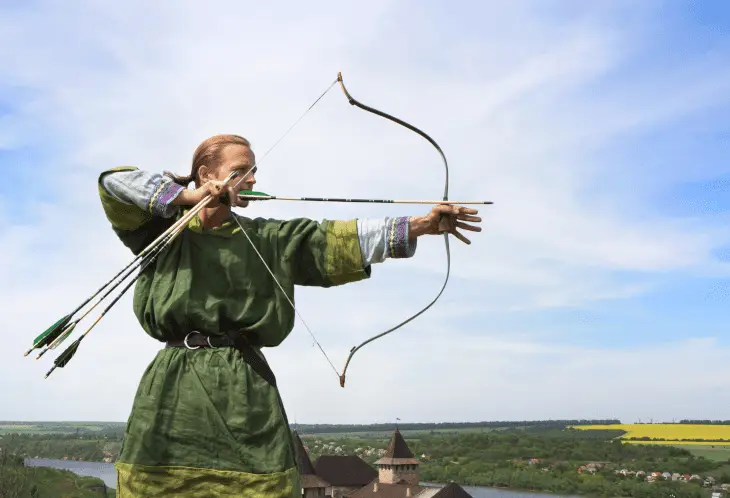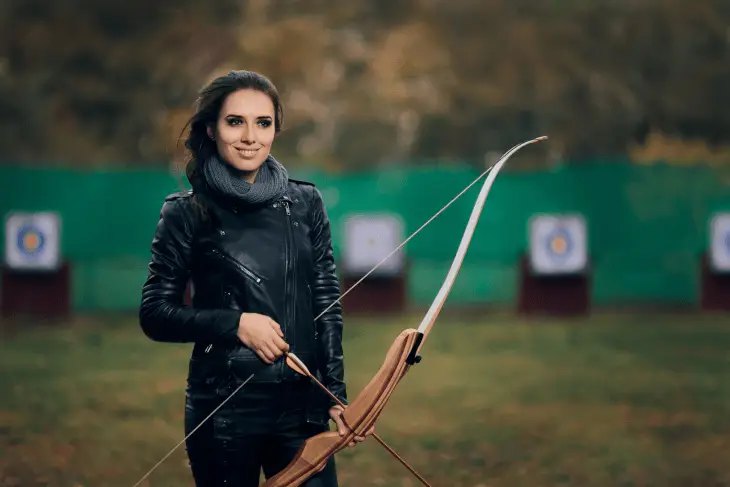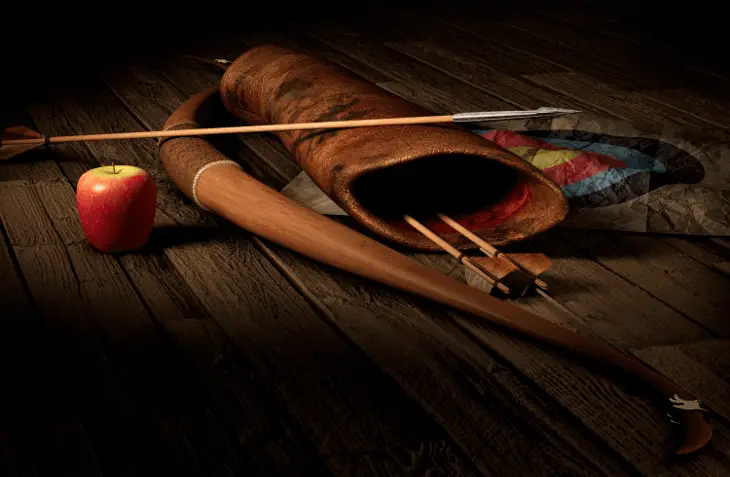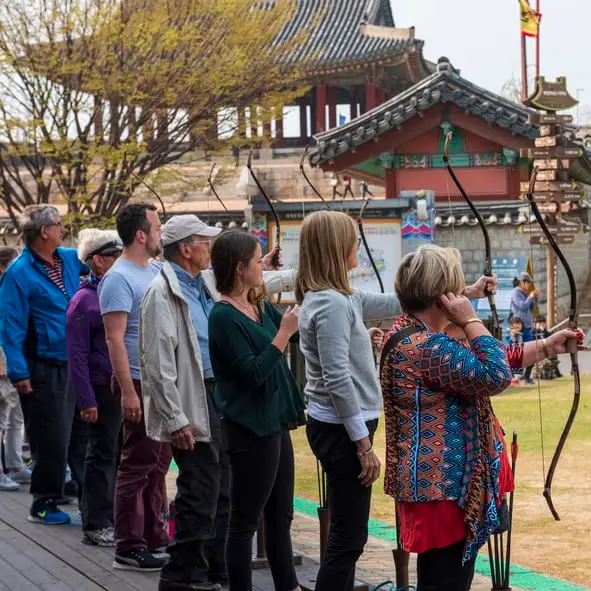
What would be your medieval weapon of choice? The longbow that defined English military culture and made the nation one of Europe’s greatest powers? Or the shortbow that made the Mongol cavalry feared from China to Europe and helped create the largest empire in history?
Longbows and shortbows both have their advantages and disadvantages. To understand which is better in a given situation, you really need to know what makes them both unique and how they’ve been used throughout the centuries.
Intro to Bow Physics
What’s so amazing about bows as machines is that all the force used to propel the arrow still comes entirely from the archer’s muscles. Nevertheless, we all know a bow can launch an arrow much faster and much farther than anyone could throw it. This is because all bows take advantage of the laws of physics to shoot arrows at blistering speeds.
Basically, bows work like springs. When you pull the bowstring back, all that energy gets stored in the string and limbs. When you release it, the bow transfers this energy to the arrow itself, sending it flying.
To compare different types and models of bows, you first have to understand the aspects of a bow that will affect how fast and how far it shoots an arrow. The primary specs that determine this are draw weight and draw length.
Draw weight refers to the amount of force required to draw the bow string. For example, a bow with 50 pounds of draw weight is as difficult to draw as it is to lift a 50-pound dumbbell off the floor. No bow is 100% efficient, but a significant portion of that 50 pounds is then transferred to the arrow.
Now take a look at the physics formulas for force:
Here, F refers to force, m to mass and a to acceleration. In other words, force is mass times acceleration. Think about what little mass an arrow has, and you’ll understand then why it achieves such high levels of acceleration.
The other major factor is draw length. This simply refers to the distance you pull the bowstring back before you fire. On traditional bows, draw length and draw weight are directly related to each other. Generally speaking, the farther back you pull a bowstring, the more force you need. Then, the bowstring has more time to apply the force to the arrow and accelerate it.
Unfortunately, there’s obviously a limit to practical draw weight. Even the tallest archer can only pull the bowstring back so far while holding the riser with the other hand. Ancient weapons like the Greek ballista often got around this by mounting long limbs with a long bowstring that several men would then pull back with a crank. These were powerful weapons with long ranges, but of course their practicality was limited. This is the same problem at the crux of the comparison between short and longbows.
Longbows
Construction and Design
Longbows are arguably the simplest type of bow. Normally made with a single piece of wood or fiberglass, longbows form a thin D shape with the bowstring attached to either end. If the bow is wood, it’s usually yew or elm. Traditionally, the bowstrings were made of animal sinew, hemp or linen, but synthetic fibers are the go-to nowadays.
Longbow designs have varied throughout the ages, but the most general definition states that a longbow is a bow whose bowstring does not touch its limbs, except at the point where it attaches.
Making a wooden longbow is a delicate process because the bow maker has to preserve the springy quality of the wood. This means preventing it from getting both too damp or too dry. Nevertheless, professional bow makers can usually make a traditional longbow in just a few hours. It’s possible that Medieval bow makers were even faster, given a proper supply of materials.
Classical and medieval longbows were incredibly long since they were weapons of war and needed as much power as possible. Most were longer than the archers using them, well over six feet in length. Modern longbows are a hobbyist pursuit, so they come in a larger range of sizes down to five feet. Still, there are plenty of extra long models out there, some approaching nearly seven feet in length.
Shooting Experience
Shooting a longbow is a full-body exercise. To achieve maximum speed and distance, you pull the string back as far as you can, which requires not only the force from your shoulders and back but also the stability of your core and legs. The heavy draw weights even mean your wrists and fingers have to be strong and coordinated.
Shooting a longbow requires an incredible amount of hand-eye coordination. Because gravity causes the arrows to drop quickly, shooting a distant target with accuracy means shooting in an arc. Unlike with a firearm where you can line the weapon up with the target, shooting a longbow requires more mental calculation and what archers usually call “instinctive aiming.” The more you practice, the better in tune you’ll get with your body and bow, learning how much you need to arc the arrow to hit the target.
Moreover, since the draw weight increases the farther back you draw the string, it’s important to be consistent to make accurate shots. If you can hit the same draw length every time, the speed and distances of your arrows will always be similar.
Longbows by the Numbers
Longbows historically shot arrows at about 130 feet per second, or FPS. Modern longbows may shoot a bit faster at up to 200 FPS. Speed directly relates to range. More speed means the arrow can travel farther before gravity pulls it down to the ground. As a result, longbows have a maximum range of around 400 yards.
This speed is produced by around 70 pounds of draw weight at close to 30 inches of draw length. For reference, the record for longbow draw weight and draw length is held by a model made by Bickerstaffe Bows in the UK and shot by Mark Stretton. It had an impressive 200 pounds of draw weight at 32.5 inches of draw length.
Historical and Modern Use
Longbows were an important weapon during the Middle Ages, which lasted from the 5th to 15th Centuries. They became especially popular towards the end of this period when they were popularized by the English army during the Hundred Years War fought between the English and French from 1337 to 1453.
At the time, the range weapon of choice for medieval armies was the crossbow. The crossbow was manufacturing intensive but required little training. Crossbowmen could lay down cover fire or protect a fortress from siege.
However, in the Battle of Agincourt in 1415, the English proved that longbows could make the difference in battle. The English army was vastly outnumbered by the French, about 25,000 to 8,000. The majority of the English force was composed of longbowmen, though, and they repeatedly picked off the charging French cavalry.
The English were successful with longbows because of their high rate of fire. The longbowmen could shoot around 12 arrows a minute, considerably more than the crossbowmen. The main downside to longbow was the amount of training needed to shoot accurately, but England overcame this obstacle by creating an entire culture of archery. Archery training was compulsory in England at the time, and boys learned from a young age, guaranteeing a large pool of available expert archers.
Although crossbows still had some advantages and remained in use for castle defense and sieges, after Agincourt, longbows became the primary range weapon for open battlefields in Western Europe.
Of course, the longbow’s time in the sun was short lived as firearms were invented and popularized shortly thereafter in the 16th Century. Now longbows are mostly for hobbyists. Specifically, archers like to recreate historical bows and test them out.
Occasionally, primitive bowhunters also use longbows. This could be because they like the challenge, or it could be because the simple design is easier to maintain on long, wilderness hunting trips.
Shortbows

Construction and Design
Shortbows are, well, short. While the maximum length is considered five feet, most are much smaller, around three feet.
They come in two different designs. They can either be miniature longbows, still shaped like a D where the bowstring doesn’t touch the limbs except where they connect. Or, they can recurve shortbows. In a recurve design, the limb curves back in toward the bowstring like an S, usually causing them to touch. This produces more speed and power with a short bow.
If a shortbow is a miniature longbow, it’s most likely made of a single piece of wood or fiberglass. However, recurve shortbows may have two separate limbs attached to a central riser. Normally the limbs are made of one material, probably wood, while the riser may be metal, most likely aluminum.
Shooting Experience
Unlike longbows, you can shoot a shortbow from many different positions. In fact, this is one of its main advantages. The effort is mostly concentrated in the upper body, the shoulders and back. Shortbow archers can even fire from a seated position.
Still, like any bow, shortbows require coordination and skill. In fact, aiming can be more difficult because shortbow arrows are shorter and lighter, so factors like wind can affect your shot a lot more. They are very accurate within a short range but lose this accuracy very quickly.
Shortbows by the Numbers
Well-designed recurve shortbows can actually have draw lengths near those of longbows, around 28 inches. Their draw weights, however, are always much lower, maybe around 30 pounds. This means lower speeds around the 100 FPS range and very short ranges of less than a couple hundred yards. They’re usually only accurate out to around five yards.
Historical and Modern Use
Shortbows saw little use in classical and medieval Europe, but they were an important weapon in Asia throughout history. The Mongols were especially adept at archery, and they used shortbows throughout the rule of Ghengis Khan in the 13th Century.
These Mongol bows had elaborate designs. They combined a bamboo core with animal horn on the belly of the bow and sinew on the back of the bow to get the most power for the shortest bow. The only downside was that the animal glue used to hold everything together could easily disintegrate in high humidity or wet weather, ruining the bow.
The Mongols wanted shortbows because they used them from horseback. If you don’t know much about Mongol history, just know that Geghis Khan successfully took over much of Asia and eastern Europe thanks to his well-trained cavalry. Archers on horses only added to this success.
Indeed, the Mongolian archers were highly skilled. A historical account from Khökh Sudar, a Mongolian philosopher, claims that in a competition at the end of the 12th Century, five archers each hit their target three times at a distance of over 500 yards. That’s better than the English longbow range.
Mongolian shortbows, also known as horsebows, became popular throughout much of the world thanks to the Mongol Empire. They were used in China, Korea, Japan, Tibet, India, Persia and as far west as Turkey. They were popular clear until the 20th Century when Asian armies began switching to firearms.
Like longbows, shortbows are no longer any kind of serious tactical weapon. They’re now used almost exclusively by hobbyists. Specifically, people like the dual sport of archery from horseback, also called mounted archery, for which shortbows are ideal. Not only do these archers need incredible bow skills to shoot accurately, they need to be able to ride and control a horse at the same time. It’s quite a sport. Today, it’s most popular in Mongolia, where it saw a revival after Mongolian independence in 1921.
Some people take mounted archery a step farther and practice mounted bowhunting. Now, generally speaking, mounted bowhunters get off their horses before shooting and can therefore have any model of bow they want. However, the most daring use shortbows and shoot from the saddle. This is not common in the US because most states have minimum draw weight requirements that are too low for shortbows.
So Which Is Better?
It should be clear that both longbows and shortbows are formidable weapons that were used historically to much success. In combat, each weapon would have its role and would excel in certain situations. First, let’s review the pros and cons of each to make it clearer when one might be the better choice over the other.
Longbow Pros:
Longer range
Higher firing speed (FPS)
Heavier arrows
Simpler construction and more durability
More power
Longbow Cons:
Bigger and heavier
Must be shot from a standing position
Heavier draw weights
Considerable training required
Shortbow Pros:
Can be shot from a seated position
Smaller and lighter
Lighter draw weights
Easier to shoot accurately
Shortbow Cons:
Shorter range
Lighter arrows
Lower firing speed (FPS)
More likely to break down
From these lists, you can probably begin to get an idea for ideal longbow and shortbow use. Since they can be shot from a seated position, shortbows are ideal for horse-mounted cavalry, especially attacking on an open field. Longbows, on the other hand, are better for defending against cavalry on an open field.
The higher power and range of a longbow make it better for sieges and defending against sieges, and the heavier arrows provide much more armor-piercing power. Again, this gives them advantage against mounted cavalry and knights in thick armor.
Meanwhile, shortbows are better for close combat as they are easier to draw, aim and shoot in awkward positions. In this way, they’re the better choice for urban warfare within the city gates or raiding a besieging encampment.
As for long campaigns, both bows have their pros and cons. Longbows are much less portable, and their high draw weights tire the archers and physically wear down their shoulder joints. After weeks of campaigning, accuracy begins to drop.
Shortbows don’t have this problem, but they can start to break down after frequent use. They’re also more affected by the elements, which means long campaigns away are more likely to cause problems than defending your home territory where you can store the weapons securely.
But Which Is More Fun?

Of course, if you’re a hobbyist, you don’t need to pick the best bow to win a battle. Just go with whichever you enjoy more. Shortbows can be fun for new archers and children who aren’t used to the heavy draw weight of a longbow. Normally, however, shortbows are used in mounted archery, target shooting from horseback. If you also happen to be an equestrian, this might be the bow for you.
Similarly, a bowhunter might go with a shortbow if they want to hunt from horseback or a confined space where they don’t have room for the more powerful longbow. They just need to make sure it’s legal to hunt with a shortbow by checking the minimum draw weight in their jurisdiction.
Either way, you should choose the bow that you enjoy more. After all, the whole point is to have fun.




